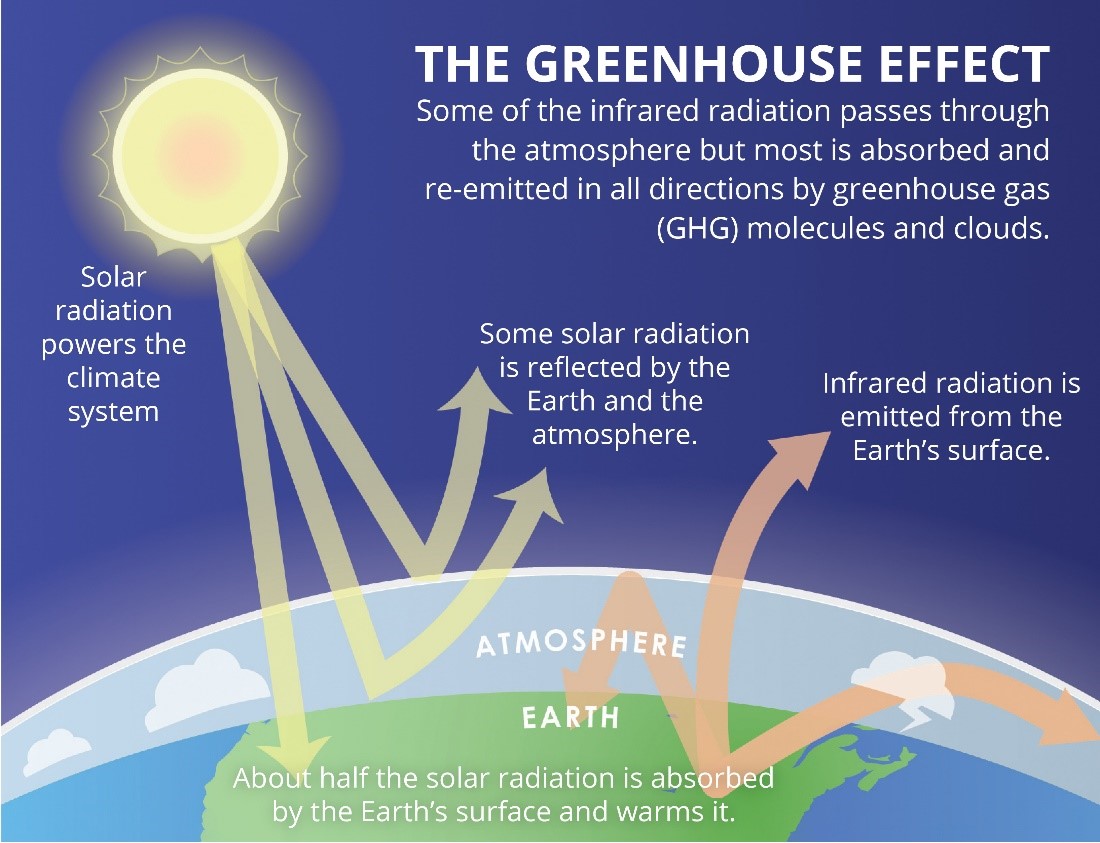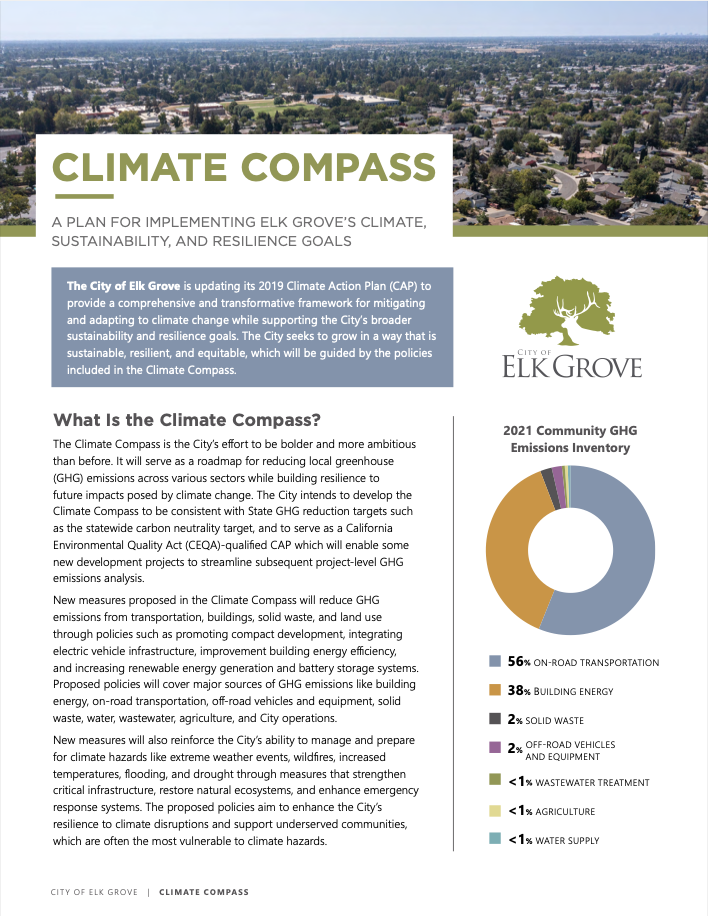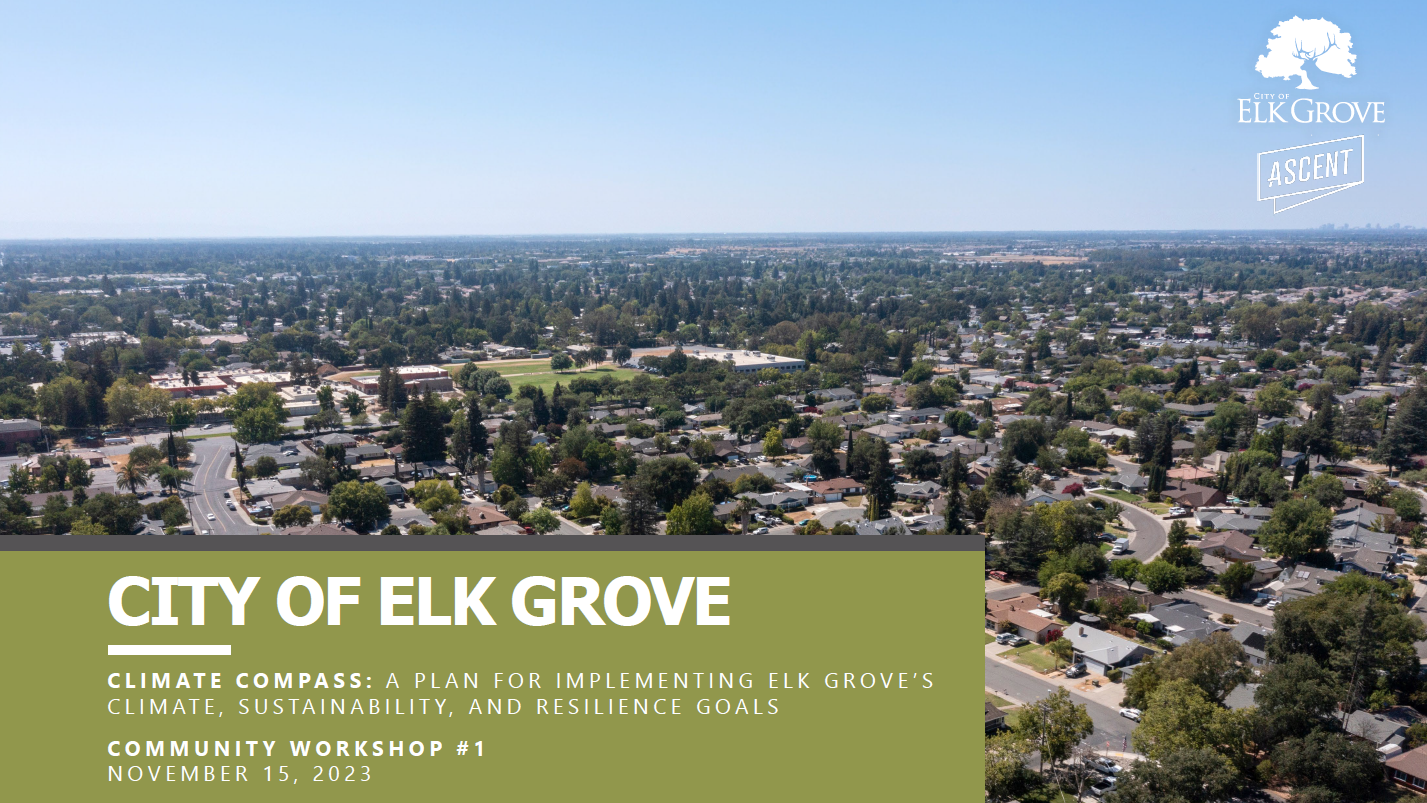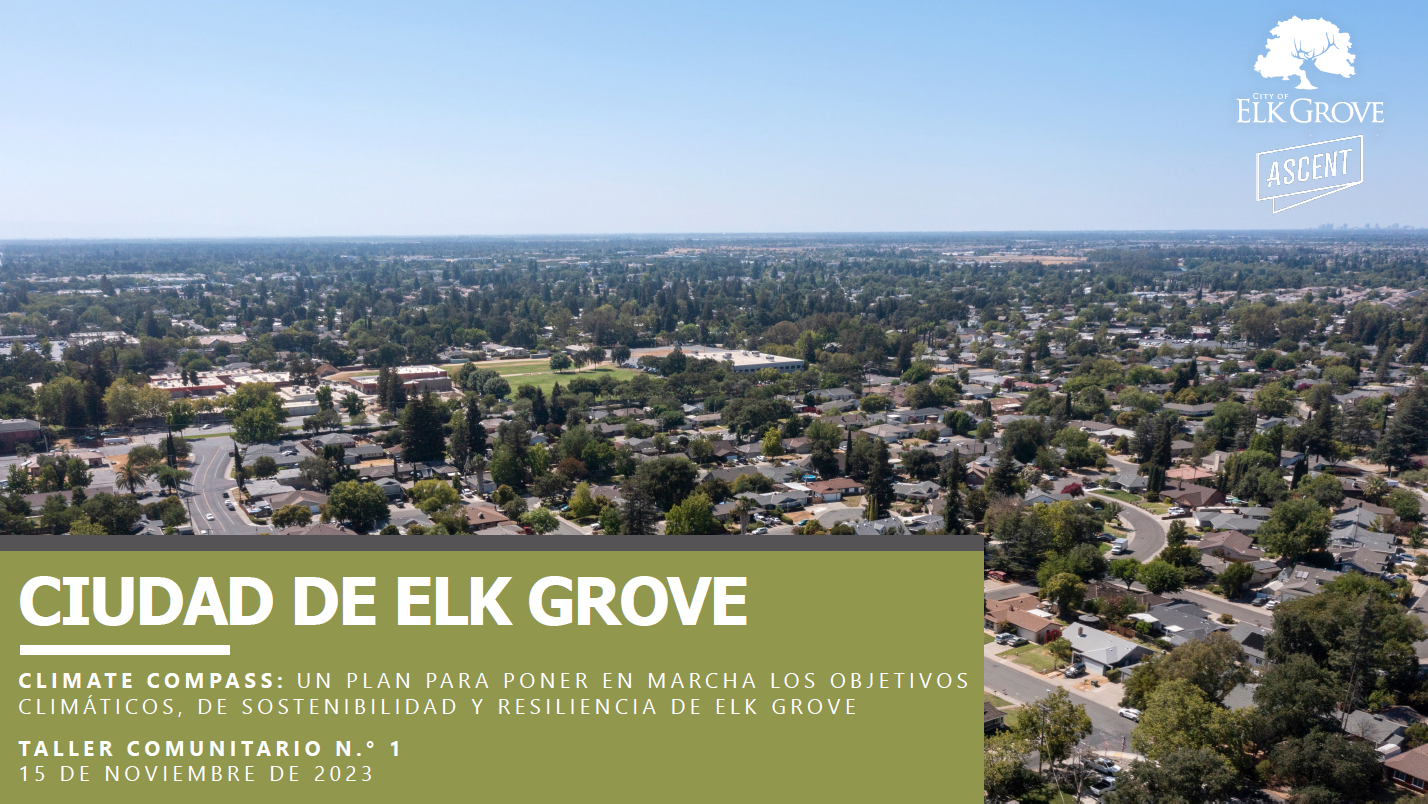Current Climate Action Plan
The Climate Action Plan (CAP) is a strategic planning document that details the City of Elk Groves commitment to reducing greenhouse gas (GHG) emissions. The CAP includes an accounting of GHG emission sources for Elk Grove, along with a framework for reducing emissions and adopting climate adaptation measures. The document identifies strategies in various sectors, including transportation, energy use, land use, and solid waste, that will help the City to achieve GHG emission reduction targets set by the State. The CAP also enables new development projects consistent with the CAP and the General Plan to tier from the environmental review process and minimize subsequent project-level analysis.
The current Climate Action Plan was adopted by the City Council on February 27, 2019 and amended in December 2019 and December 2022.
Sign Up For Updates
Climate Compass
Elk Grove is in the process of updating the 2019 CAP, providing direction for the City on implementing climate, sustainability and resilience goals. The Climate Compass will ensure the action plan continues to be consistent with new State laws, such as AB 1279, with the 2022 CARB Scoping Plan, and as a CEQA tiering document. The development of the Climate Compass, the update to the 2019 Climate Action Plan, started in spring 2023 and will continue through summer 2025 and involve many opportunities for public engagement.
Information Sessions
In July and August 2024, staff provided a series of three information sessions at City Council meetings related to the Climate Compass. These sessions outlined information from the GHG inventory and forecast, and identified ideas for strategies and actions the City could include in the draft Climate Compass that would mitigate GHG emissions.
Session 1: Overview of GHG Inventory and Forecast, Smaller Sector Actions
Session 2: Building Energy
Session 3: Transportation
Greenhouse Gas Emissions Inventory and Forecast
A community-wide and local government operations (LGO) greenhouse gas (GHG) emissions inventory and forecast were conducted using 2021 data, the most recent year available at the time the inventories were done.
A GHG emissions inventory and forecast are important building blocks for addressing climate action. A community-wide GHG emissions inventory provides a baseline of information on the largest emissions sectors for the community. A GHG emissions forecast provides information on how emissions may change in the future, with community growth.
A local government operations GHG emissions inventory provides information on the GHG emissions resulting from the operations and services of local government functions.
The details for the inventory and the forecast are available.
Community Virtual Workshop
The City of Elk Grove held the first Climate Compass community workshop on Wednesday, November 15, 2023. The purpose of this first community workshop was to share information about the goals of the Climate Compass, and hear from residents about key climate related vulnerabilities in Elk Grove as well as identifying community strengths. This input will be used to help identify priority areas and actions, and to build on the community strengths as actions are identified. Slides from the workshop are available. Future engagement opportunities will be coming.

The goal of the Climate Ambassador Program is to improve resident knowledge of and engagement around climate efforts. Climate Ambassadors are encouraged to have conversations with members of their community and share input on how Elk Grove can be healthier, more sustainable and resilient. Climate Ambassadors use their existing knowledge and gain additional understanding of topics around climate change, environmental justice, equity, renewable energy, clean transportation, water conservation, and recycling and waste. These efforts will help to develop a more community and equity focused Climate Compass and support greater community participation in reaching the climate goals.
Timeline
- Kick-off of Public Engagement: Summer 2023
- Greenhouse Gas Inventory Update: Completed in Fall 2023
- Proposed GHG Reduction Measures, Strategies and Actions: Summer 2024
- Environmental Documentation: Late Summer/Fall 2024
- Public Draft of Climate Compass: Fall/Winter 2024
- CEQA Review: Fall/Winter 2024
- Public Hearings and Adoption: Spring/Summer 2025
- Implementation: Ongoing

Frequently Asked Questions
What is the Climate Compass?
The Climate Compass is the name for the update to the City of Elk Grove’s 2019 Climate Action Plan (CAP) to be bolder and more ambitious than before. It is a comprehensive and transformative roadmap for addressing climate change while supporting the City’s broader sustainability and resilience goals.
Why is the City of Elk Grove updating its Climate Action Plan?
The purpose of the Climate Compass is to identify measures and approaches that reduce greenhouse gas (GHG) emissions and help the City adapt to the current impacts of climate change. It serves to guide City staff in implementing climate, sustainability, and resilience goals that meet present needs without compromising the ability of future generations to meet their own needs. The City intends to develop the Climate Compass to be consistent with State GHG reduction targets such as the statewide carbon neutrality target and as a California Environmental Quality Act (CEQA)-qualified CAP.
What is mitigating and adapting to climate change?
Mitigation is the process of lessening heat trapping GHG emissions that contribute to climate change. Using baselines GHG emission calculations, the City can project future GHG emissions to help develop targets and strategies intended to reduce future emissions. Strategies can include decreasing where these GHG gases come from, like reducing the burning fossil fuels for energy, or enhancing the places that store these gases, like better managing urban forests and soil.

Adaptation refers to the process of assessing and responding to climate change's current and future impacts. The City can measure its adaptive capacity to respond to these impacts by assessing climate-related hazards and pinpointing vulnerabilities to develop effective strategies. Adaptation strategies will include efforts to improve community resilience and help prepare for climate hazards like extreme weather events, wildfires, increased temperatures, flooding, and drought.

What is a CEQA-qualified CAP and why is the City developing one?
A CEQA-qualified CAP is one that meets State requirements so that future development projects requiring CEQA can streamline GHG impact analyses by demonstrating consistency with the CAP. It will allow for consistency in the GHG reducing and climate adaptation features that are included as part of the design of new development projects.
Demonstrating compliance with a CEQA-qualified CAP provides a simple, clear, and defensible option for project-level analyses to determine that its incremental contribution is not cumulatively considerable. This approach is supported and recommended by the California Air Resources Board, Governor’s Office of Planning and Research, multiple local air districts, and has been reinforced through CEQA case law.
What benefits are there for Elk Grove residents?
The Climate Compass will contain measures (i.e., policies) supporting reduced energy consumption in buildings, which can lead to substantial cost savings for residents that participate. It will provide alternative transportation options through non-motorized travel modes, reduce the number of vehicles on the roads, and support the electrification of vehicles so that less emissions occur. The plan also identifies strategies to address climate vulnerabilities to reduce climate impacts from extreme weather events, temperature increases, wildfires, flooding, and drought.
Why should I get involved?
A successful CAP will rely on collaboration with residents, business owners, community leaders, and advocates in underserved communities. The Climate Compass should reflect the Elk Grove community’s priorities and vision, so it is important that we hear from as much of our community as possible to ensure climate risks or potential recommendations are not overlooked, as well as reducing the potential for unintended consequences of proposed measures.
How can I stay involved in the process?
Sign up for periodic updates at the top of this page. The City will be hosting online community workshops, in-person pop-up events, and focus group meetings and will continue to update the website with pertinent information and opportunities to comment on draft documents. Thank you for taking the time to be part of the Climate Compass development process!
Is it Climate Compass or CAP?
Both! The City has branded the update to its 2019 CAP as Climate Compass: A Plan for Implementing Elk Grove’s Climate, Sustainability, and Resilience Goals.
Can you define greenhouse gases and climate change?
GHGs are gases that trap heat in the atmosphere, and consist mainly of water vapor, carbon dioxide, methane, nitrous oxide, ozone, and chlorofluorocarbons. GHGs provide an insulating effect to Earth, which is necessary to support life. However, the combustion of fossil fuels and other human-caused activities since the Industrial Revolution in the 19th century have introduced GHGs into the atmosphere at an increasingly accelerated rate. These significantly elevated levels of GHGs above natural ambient concentrations have caused a trend of unnatural warming of the Earth’s climate. This effect, known as global climate change, is the driver behind changes in extreme weather patterns, rapid melting of the polar ice caps, an increase in sea level, and other impacts to biological resources and humans.
Three primary GHGs are quantified in the City’s inventory: carbon dioxide (CO2), methane (CH4), and nitrous oxide (N2O).

How are GHG emissions calculated in the Climate Compass?
Emissions of these gases are converted to a comparable unit by multiplying each non-CO2 gas by their global warming potential (GWP), enabling the reporting of emissions in terms of carbon dioxide equivalent (CO2e). This conversion allows consideration of all gases in comparable terms and makes it easier to communicate how various sources and types of GHG emissions contribute to climate change. Emissions are reported in metric tons of CO2e (MTCO2e), the standard measurement for the amounts of GHG emissions produced and released into the atmosphere. GWP values for CH4 and N2O included in the Intergovernmental Panel on Climate Change (IPCC) Sixth Assessment Report were used for calculating emissions estimates.
What makes up the City’s GHG inventory?
A GHG emissions inventory provides an estimate of the annual emissions associated with a jurisdiction’s community-wide activities. GHG emissions inventories are a critical component of the Climate Compass process and are used to establish a baseline, develop reduction targets/goals, and monitor emissions over time. Local government GHG inventories are based on activities that a jurisdiction has control or influence over within its boundaries. The City’s inventory will be made available on the City’s website.
Which emission sectors and sources are included in the GHG Inventory?
The Climate Compass’s GHG inventory will include emissions generated from sources and activities that occur within the boundaries of the city and over which the City has operational control, regulatory authority, or significant influence. The GHG inventory will include sectors and sources in both communitywide and City operations.
The communitywide inventory will include GHG calculations for on-road transportation, building energy, solid waste, off-road vehicles and equipment, wastewater treatment, water supply, and agriculture.
The City operations inventory will include GHG calculations for City-owned buildings and facilities, streetlights and traffic signals, employee commute, vehicle fleet, solid waste, wastewater treatment, and water supply.
Keep Up to Date
Please sign up at the top of the page to receive email updates as the project progresses.
For questions contact Carrie Whitlock.




